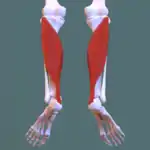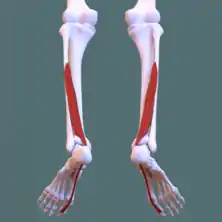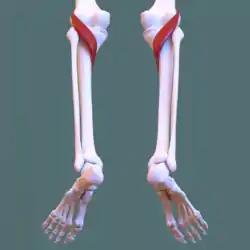Posterior compartment of leg
The posterior compartment of the leg is one of the fascial compartments of the leg and is divided further into deep and superficial compartments.
| Posterior compartment of leg | |
|---|---|
 Diagram of leg compartments | |
Dissection video of posterior compartment of leg (6 min 39 sec) | |
| Details | |
| Artery | posterior tibial artery |
| Nerve | tibial nerve |
| Identifiers | |
| Latin | compartimentum cruris posterius |
| TA98 | A04.7.01.006 |
| TA2 | 2654 |
| FMA | 45167 |
| Anatomical terminology | |
Structure
Superficial posterior compartment
| Image | Muscle | Origin | Insertion | Innervation | Main Action ! |
|---|---|---|---|---|---|
 |
Gastrocnemius | Lateral head: lateral aspect of lateral condyle of femur Medial head: popliteal surface of femur; superior to medial condyle | Posterior surface of calcaneus via calcaneal tendon | Tibial nerve (S1, S2) | Plantarflexes ankle when knee is extended; raises heel during walking; flexes leg at knee joint |
 |
Plantaris | Inferior end of lateral supracondylar line of femur; oblique popliteal ligament | Weakly assists gastrocnemius in plantarflexing ankle | ||
 |
Soleus | Posterior aspect of head and superior quarter of posterior surface of fibula; soleal line and middle third of medial border of tibia; and tendinous arch extending between the bony attachments | Plantarflexes ankle independent of position of knee; steadies leg on foot |
Deep posterior compartment
| Image | Muscle | Origin | Insertion | Innervation | Main Action |
|---|---|---|---|---|---|
 |
Flexor hallucis longus muscle | Inferior two-thirds of posterior surface of fibula; inferior part of interosseous membrane | Base of distal phalanx of big toe (hallux) | Tibial nerve (S1, S2) | Flexes big toe at all joints; weakly plantarflexes ankle; supports medial longitudinal arch of foot |
 |
Tibialis posterior muscle | Interosseous membrane; posterior surface of tibia inferior to soleal line; posterior surface of fibula | Tuberosity of navicular, cuneiform, cuboid, and sustentaculum tali of calcaneus; bases of 2nd, 3rd, and 4th metatarsals | Tibial nerve (L4, L5) | Plantarflexes ankle; inverts foot |
 |
Flexor digitorum longus muscle | Medial part of posterior surface of tibia; by a broad tendon to fibula | Bases of distal phalanges of lateral four digits | Tibial nerve (S1, S2) | Flexes lateral four digits; plantarflexes ankle; supports longitudinal arches of foot |
 |
Popliteus muscle | Lateral surface of lateral condyle of femur and lateral meniscus | Animation. Posterior surface of tibia, superior to soleal line | Tibial nerve (L4, L5, S1) | Weakly flexes knee and unlocks it by rotating femur 5 deg on fixed tibia; medially rotates tibia of unplanted limb |
Blood supply
Innervation
The posterior compartment of the leg is supplied by the tibial nerve.
Function
- It contains the plantar flexors:[4]
Additional images
 Superficial posterior compartment. Animation.
Superficial posterior compartment. Animation. Deep posterior compartment. Animation.
Deep posterior compartment. Animation.
References
- Moore, Dally and Agur (2014). Moore Clinically-Oriented Anatomy, Table 5.13.I, p 597.
- Moore, Dally, and Agur (2014). Moore Clinically-Oriented Anatomy, Table 5.13.II, p 598.
- "Muscle Database - sorted by muscle location". Archived from the original on 2012-10-18. Retrieved 2014-05-10.
- postleg at The Anatomy Lesson by Wesley Norman (Georgetown University)
External links
Wikimedia Commons has media related to Posterior compartment of the human leg.
This article is issued from Wikipedia. The text is licensed under Creative Commons - Attribution - Sharealike. Additional terms may apply for the media files.